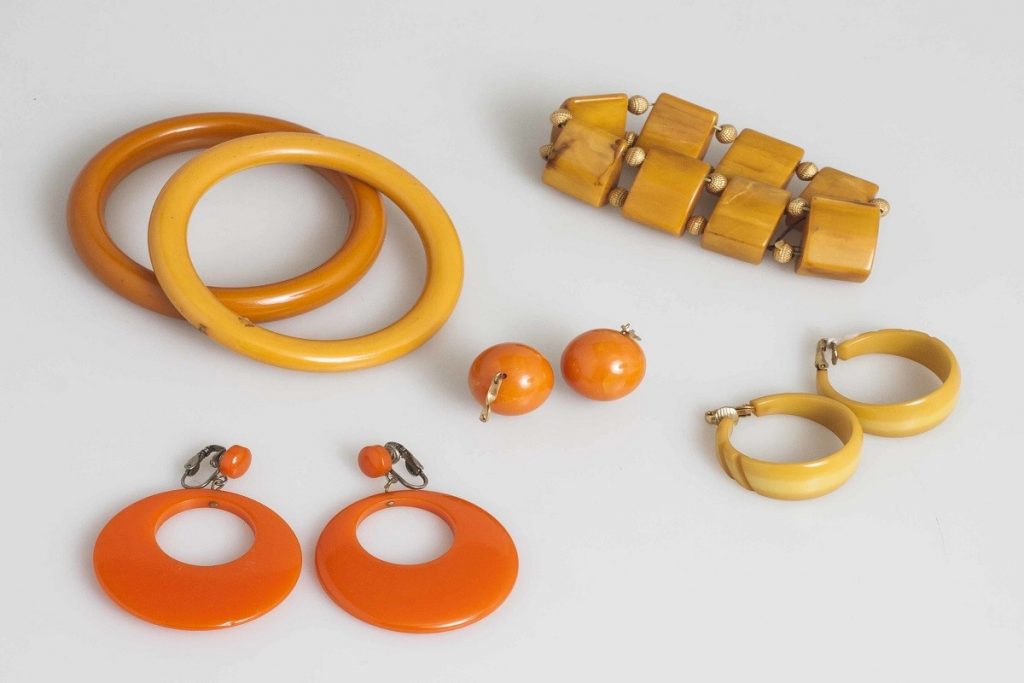Would you know how to spot a genuine piece of bakelite jewelry? Many people are not familiar with Bakelite jewelry, and it may not be a term that you have come across before.
In a nutshell, Bakelite jewelry is made from a lightweight plastic, and was created in the 1900s, and became very popular in the 1930s. It became very popular around the time of the Depression, when the financial position of many Americans meant that women were looking for accessories that they could buy cheaply to dress up their outfits.
Bakelite jewelry fitted the bill, especially as it was available in a variety of colors. Many pieces of Bakelite jewelry were designed to imitate coral, ivory, amber and tortoiseshell, which would have been much more expensive to buy. If women bought these pieces of jewelry, they could easily look like they were wearing jewelry that was much more expensive and sophisticated than it actually was.
As well as being a favorite of the less well off, Bakelite jewelry also appealed to those with more money. The more intricate, heavy detailed pieces of Bakelite jewelry were designed with the rich in mind.
They sold at department stores for a substantial amount of money, as very few were produced. These types of jewelry are now highly sought after by collectors of Bakelite jewelry.
Bakelite jewelry is made from plastic, and refers to a form of jewelry that is heavily carved, and can include details in the form of polka dots and multiple colors that are laminated together. These details are in demand by collectors of Bakelite jewelry.
Common colors are butterscotch and pea green. These also tend to be the least expensive colors to buy, as more of them are produced. Bangles seem to be the most popular types of jewelry, but pins, rings and necklaces are also becoming items that are more popular with collectors.
How to tell if a piece of jewelry is an authentic piece of Bakelite jewelry?
There are several ways to tell if a piece of jewelry is genuinely Bakelite or not. These usually include testing the feel, sound, smell and overall look of the jewelry for small indications.
Look
Fake pieces often have a chalky appearance along the ridges of the carving. This has the appearance of dust, but it cannot be removed. It is not a good idea to scrub at the chalkiness, as this will probably damage the jewelry.
Here is a test, how to test bakelite jewelry:
Genuine Bakelite jewelry is likely to have some signs of wear and tear that indicate that it is not a new piece of jewelry. You may need to use a magnifying glass to look for the tiny scratches and chips that are usually present on authentic pieces of Bakelite jewelry. It is unusual for genuine Bakelite pieces to be completely devoid of scratches or chips, given that they date back to the 1930s or earlier.
Another good test is to rub the jewelry with Simichrome jewelry polish. It is non-abrasive, so it is often used to clean various types of material. If a small amount of the polish is rubbed onto the back or the inside of genuine Bakelite jewelry, the cloth will usually turn yellow.
However, there are some exceptions to this rule. If the Bakelite piece is lacquered, it will not pass this test. Likewise, if the jewelry is made from black Bakelite, it will also fail the test.
The test can also be done using Formula 409, but if the Bakelite is black or lacquered, it will not pass the test with this either. If your piece of jewelry fails this particular test, it is worth conducting some of the other tests, as it is not necessarily a fake just because it does not pass this particular test.
Feel
Bakelite jewelry tends to feel heavier than many other types of jewelry. If you hold two pieces of jewelry in opposite hands (one piece that is Bakelite, and one piece that is not), there should be a difference in the weight of each piece. If there is not, the Bakelite is unlikely to be genuine.
Sound
Genuine Bakelite jewelry that is tapped together will make a clunking sound. This often happens when you are wearing more than one bangle at the same time, and they will then obviously jangle together as you move. If yours do not make this sound, there is a very good chance that at least one of the pieces is fake.
However, it is not necessarily as straightforward as this, as the sound that is produced will depend on how dense the Bakelite material is. Therefore, it is not the most reliable test of authenticity.
Smell
A good way to test the smell is to rub the piece of jewelry gently until it begins to heat up. At this point, the jewelry should smell of chemicals (formaldehyde to be precise).
The chemical smell is the result of the carbolic acid within the Bakelite. Alternatively, you can run the jewelry under the hot tap for a brief period of time. This should produce the same smell.
If the jewelry does not have a chemical smell, it is likely that it is not a genuine piece of Bakelite jewelry. This test is especially useful when trying to test Bakelite bangles. The strength of the smell will be different according to the type of Bakelite that the jewelry is made from – some types will produce a very strong smell, whilst others will emit a very faint smell that is difficult to pick up.
The hot pin test
If you touch a hot pin (one that was been in close contact with an open flame) to the Bakelite, it should be immediately obvious as to whether the item is genuine Bakelite or not. A genuine piece of Bakelite will not be permeated by the pin. Instead, it will merely leave a burn mark.
For this reason, it is best to conduct this test on the inside of the Bakelite, where the burn mark will not be noticeable. The obvious safety rules apply here – as the hot pin needs to have been inserted into a very hot open flame, it is advisable to do this using a set of tongs, or other instrument that mean that you do not have to risk your fingers being burned by the flame.
French Bakelite
Contrary to the name, French Bakelite is not actually Bakelite. It has no chemical link to Bakelite, so it will almost definitely fail the authenticity tests.
As well as France, it was also produced in Germany. It ceased to be produced after the start of the Second World War.
Bakelite jewelry can be bought at some flea markets, some it could pay to have a look around during your next visit. The plastic jewelry that you have probably overlooked until now could be genuine Bakelite jewelry, which means you could have a rare and lucrative piece of jewelry in your hands!

